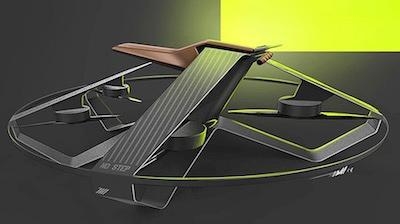More Than 160 Teams Competed For The Prize Sponsored By Boeing
A panel of aviation experts has selected 10 winners in the first phase of the GoFly competition sponsored by Boeing.

Lauren Schumacher says she “caught the aviation bug” at a young age. The 24-year-old seeking her PhD in guided munitions would sit with her parents and marvel at air shows or watch wide-eyed as an A-10 performed runs at nearby Fort Leonard Wood in Central Missouri.
Well, she’s no longer just a spectator.
Schumacher and her team from the University of Kansas were selected as one of winners in Phase I of the GoFly Prize. More than 160 teams from 33 countries competed for $200,000 in prizes. “We were all just shocked, considering how many teams had entered,” said Schumacher, who captains a group of seven students and one faculty advisor from Kansas.
Schumacher and her team (Mamba) (pictured) came up with a hexcopter with shrouded rotors and a tilting empennage.
“To be able to engage so many individuals from leading universities, major corporations and startups, and connect them through our community of innovators enables us to impact the industry in an unprecedented way,” said GoFly CEO Gwen Lighter. “We know that the road to personal flight is long and difficult, but we are incredibly encouraged and inspired by the volume of strong submissions that we have received in Phase I. This is only the beginning.”
For Phase I, teams were asked to submit a design of a personal flying device that takes off vertically, safely and quietly and carries someone at least 20 miles. “We certainly evolved from our initial concept,” said Schumacher, whose team originally leaned toward a more motorcycle-like design. “Initially, we thought of marketing it more as recreational. Then we began to emphasize safety with the shrouded rotors and meshed look. We also went with the multi-engines in case one became inoperative. We wanted to make it safe and certifiable for personal transportation.”
As they proceeded, Schumacher said their aircraft began to look more like the head of a snake, inspiring the name “Mamba.”
In the early stages, Team Mamba discussed electric propulsion for a quieter and more environmentally friendly device, but they quickly realized battery technology fell short of their performance goals.

Meanwhile, another Phase I winner opted to go hybrid (pictured).
“The hybrid-electric propulsion system combines the advantages of both high energy-density fuel and electric motors, enabling long flight range, simpler stabilization control, reduced weight and mechanical complexity, and quiet operation,” said Bruno Howard, captain of the Leap team and a mechanical engineer from London. “The design could theoretically be built and flown today with off-the-shelf components and no reliance on further technological developments.”
Other Phase I winning teams are: Aeroxo AC of Latvia (ERA Aviabike); Blue Sparrow of U.S. (Blue Sparrow); Georgia Tech of U.S. (HummingBuzz); Scoop of U.S. (Pegasus I); Silverwing of The Netherlands (Silverwing); teTra of Japan (teTra 3); Texas A&M University of U.S. (Harmony); and Trek Aerospace of U.S. (Flykart2).
Almost 3,000 innovators from 725 teams and 95 countries have signed up for GoFly.
The registration deadline for the second phase of the competition – updated reports and demonstration of progress in development – is in December. Participants do not have to win a prize in Phase I to continue in the competition, and new teams can join in Phase II. Up to four $50,000 prizes will be awarded in Phase II based on revised Phase I material (or for new teams new Phase I material) and demonstrated performance of progress to date.
Boeing has seeded the competition with $2 million in prize money paid out over the three-phase competition. The ultimate winner of the fly-off in October 2019 will receive $1 million. Awards for the quietest and smallest devices are $250,000 each.
“For us, taking part in the GoFly challenge is about more than competing for the award,” Howard said. “Here at Leap, we are in no doubt that urban and other transit routes will move to the skies as societal and regulatory hurdles are gradually overcome, and we are excited to be able to pursue our vision alongside GoFly, Boeing and other leading aerospace companies as part of the competition.”
Schumacher, who spends 40 to 60 hours a week on the GoFly project, can’t wait for the next stage.
She added, “We’re super excited to see what everyone else has designed and to get on with Phase II.”
(Images provided with Boeing news release)
 Airbus Racer Helicopter Demonstrator First Flight Part of Clean Sky 2 Initiative
Airbus Racer Helicopter Demonstrator First Flight Part of Clean Sky 2 Initiative Diamond's Electric DA40 Finds Fans at Dübendorf
Diamond's Electric DA40 Finds Fans at Dübendorf ANN's Daily Aero-Term (04.23.24): Line Up And Wait (LUAW)
ANN's Daily Aero-Term (04.23.24): Line Up And Wait (LUAW) NTSB Final Report: Extra Flugzeugbau GMBH EA300/L
NTSB Final Report: Extra Flugzeugbau GMBH EA300/L Classic Aero-TV: 'Never Give Up' - Advice From Two of FedEx's Female Captains
Classic Aero-TV: 'Never Give Up' - Advice From Two of FedEx's Female Captains




